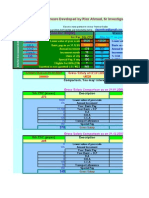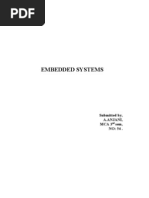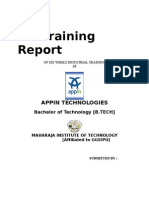Emb 2
Uploaded by
api-3761679Emb 2
Uploaded by
api-3761679Paper2
PRESENTED BY:
K.MYTHREYI
D.PRATHYUSHA
WITH THE ASSISTANC E OF
ASSOC .PROF.MR.B.SHANKAR RAO
ABSTRAC T
Each day our lives become more dependent on “Embedded systems”, digital information
technology that is embedded in our environment. This includes not only the safety critical
applications such as automotive devices medical devices and controls, but also communications,
mobile worlds and e-worlds the smart home, factories etc. All of these have wide ranging impacts
on society including security, privacy and modes of working and living. More than 98% of
processors applied today are in embedded systems and no longer visible to the customer as
computers, in the ordinary sense. New processors and methods of processing, sensors, actuators,
communications and infrastructures are ‘enablers' for this very pervasive computing. They are in
sense ubiquitous, that is, almost invisible to the user and almost omnipresent. As such they form
the basis for a significant economic push. The need to carry some specific tasks by using
hardware and software made the advent of “Embedded Systems”.
This paper presents, Definition, Typical Embedded Systems Organisation . Different C ategories of
“Embedded Systems” , Practical Requirements of “Embedded Systems “ and Applications of
embedded systems.
The applications of embedded systems include the electronics we use in our day-to-day life.
Physically, embedded systems range from portable devices such as digital watches and MP3
players , to large stationary installations like traffic lights , factory controllers, or the systems
controlling nuclear power plants . . This paper seeks to expand the area of discussion to
encompass a wide range of embedded systems
INTRODUCTION
Man's immense case to find new things for making life as comfortable as possible lead to the
invention of many new things like radio, T.V., etc and at one stage leading to the invention of
computers. This invention has changed the life of many completely and made world enter in to a
new phase of technology. This invention brought in to light many fields which are bringing
unimaginable things at the doorstep of common man. One such field is "EMBEDDED
ENGINEERING".
WHAT EXACTLY IS AN "EMBEDDED SYSTEM"?
It's difficult, and highly controversial, to give a precise definition. So, here are some examples.
Embedded systems are in every "intelligent" device that is infiltrating our daily lives: the cell
phone in your pocket, and all the wireless infrastructure behind it; the Palm Pilot on your desk;
the Internet router your e-mails are channeled through; your big-screen home theater system;
the air traffic control station as well as the delayed aircraft it is monitoring! Software now makes
up 90 percent of the value of these devices.
WHAT EXACTLY IS AN "EMBEDDED SYSTEM"?
An embedded system is a special-purpose system in which the computer is completely
encapsulated by or dedicated to the device or system it controls. Unlike a general-purpose
computer, such as a personal computer , an embedded system performs one or a few pre-defined
tasks, usually with very specific requirements. Since the system is dedicated to specific tasks,
design engineers can optimize it, reducing the size and cost of the product. Embedded systems
are often mass-produced, benefiting from economies of scale .
HISTORY:
In 1968, the Volkswagen 1600 used a microprocessor in its fuel injection system, launching the
first embedded system in the automotive industry.
The first mass-produced embedded system was the guidance computer for the Minuteman missile
which made the integrated circuits reach a usable price-point. It used integrated circuits having a
crucial desired feature of reprogramming its guidance algorithm later in the program to make the
missile more accurate.
HOW DO YOU BUILD AN EMBEDDED
SYSTEM?
To create an embedded system, the
electronic and software engineer will
design an appropriate set of specialised
hardware (possibly including a
microcontroller and associated circuitry)
for a special-purpose control application.
He or she will then write appropriate
software - perhaps in the programming
language C, C++ or Java - to control the
hardware.
Characteristics:
l Embedded systems often use a (relatively) slow processor and small memory size with an
intentionally simplified architecture to minimize costs.
l Programs on embedded systems must often run with limited resources
l Embedded system designers use compilers to develop an embedded system.
l They often have no operating system or a specialized embedded operating system (often a
real-time operating system ).
l Provides a continuous efficient power source to operating devices avoids redundant
measures, eliminate compatibility concerns, and minimize exposure to adverse
environmental conditions. As embedded systems use relatively slow processors, whole
architecture of the computer is often intentionally simplified to lower costs. For example,
embedded systems often use peripherals controlled by synchronous serial interfaces, which
are ten to hundreds of times slower than comparable peripherals used in PC s.
l Programs on an embedded system often must run with resources: often there is no disk
drive, operating system, keyboard or screen. may replace rotating media, and a small
keypad may be used instead of a PC 's keyboard and screen.
l Embedding a computer is to interact with the environment, often by monitoring and
controlling external machinery. In order to do this, analog inputs and outputs must be
transformed to and from digital signal levels.
LIFE-CYCLE SUPPORT:
First a need or opportunity to deploy new technology is identified. Then a product concept is
developed. This is followed by concurrent product and manufacturing process design, production,
and deployment. But in many embedded systems, the designer must see past deployment and
take into account support, maintenance, upgrades, and system retirement issues in order to
actually create a profitable design.
CATEGORIES OF EMBEDDED SYSTEMS :-
B ased on functionality and performance requirements, embedded systems scan be categorized
as:
1. Stand-alone Embedded Systems
2. Real Time Embedded Systems
3. Networked Appliances
4. Mobile Devices
1. Stand-alone Embedded Systems:
• Work in stand-alone mode. (As opposed to networked mode)
• Inputs can be electrical signals from sensors, or commands from a human being.
• Output can be electrical signals to drive another system, or an LED or LC D display displaying
information to users.
2. Real Time Embedded Systems:
Required to carry out specific tasks in a specified amount of time Divided into two categories:
–Hard Real Time Systems
–Soft Real Time Systems
(i). Hard Real Time Systems:
A system that has to open a valve within 30ms when the humidity crosses a particular threshold.
If the job is not carried out within 30ms, a catastrophe may ensure. Such systems with real time
constraints are called as Hard Real Time Systems .
(ii). Soft Real Time Systems:
Real Time "constraints" are often imposed in voice and video communication, but if these
constraints are violated occasionally, nothing catastrophic will happen. For instance voice packet
will be delayed resulting in a short silence. Such systems are called Soft Real Time Systems.
A real-time operating system ( RTOS ) is a multitasking operating system intended for real-
time applications. Such applications include embedded systems (programmable thermostats,
household appliance controllers, mobile telephones ), industrial robots , spacecraft, industrial
control (see SC ADA ), and scientific research equipment
3. Networked Appliances:
Some ES are connected to the N/W. The system can monitor some parameters and send the data
over a network to a centralized system for online monitoring. A system at manufacturing unit
sending data over the TC P/IP network to a central management system which can be Desktop
computer running a browser. These are known as Internet Information Appliances.
4. Mobile Devices:
With the advent of high speed wireless networks, Mobile devices capable of supporting high data
rate should be designed, Accessing E-mail, WWW and so on can be them from a significant
portion done while the person is on move. Many such devices are Java Enabled, hence they can
download and execute Java Applets.
Hence a powerful processor, powerful OS and lots Of memory with minimal power
consumption is required.
AC TUALLY WHERE ARE THESE EMBEDDED SYSTEMS USED?
Embedded systems are computing systems that are designed for a specific application and are
embedded in a technical context, e.g. mobile phones, smart cards, vehicular electronics,
consumer electronics devices, etc The growing interest in the systematic design of such systems is
motivated by the increase both in variety and complexity of the embedded applications systems
have long overtaken PC s in terms of numbers...
EXAMPLES OF EMBEDDED SYSTEMS:
l Avionics , such as inertial guidance systems , flight control hardware/software and other
integrated systems in aircraft and missiles
l C ellular telephones and telephone switches
l engine controllers and antilock brake controllers for automobiles
l Home automation products, such as thermostats , air conditioners , sprinklers , and
security monitoring systems
l Handheld calculators
l Handheld computers
l Household appliances , including microwave ovens , washing machines , television sets,
DVD players and recorders
l Medical equipment
l Personal digital assistant
l Videogame consoles
l C omputer peripherals such as routers and printers
l Industrial controllers for remote machine operation.
A PPLICATIONS OF EMBEDDED SYSTEMS:
Embedded systems are now ubiquitous. They can be found in a diverse range of appliances, from
mobile phones to smoke alarms, from refrigerators to trucks. Enabling these systems to
communicate opens up new areas of applications: smart buildings, industrial automation,
healthcare, power distribution and host of others. Some of the applications will result in a more
efficient, accurate or cost effective solution than previous ones. Others will be new, previously
unimagined or impossible. We are in the middle of a major technological revolution that will affect
many aspects of our lives, and Europe is well placed to be at the forefront of exploiting this
technology
EMBEDDED MICROPROCESSOR:
Embedded microprocessors are essentially microprocessors that are used in everyday
electronic devices, such as cellular telephones, household appliances, automobiles, or virtually
any electronic device you could think of. Unlike microprocessors , which are usually used in
computer systems , embedded microprocessors are usually designed to perform a certain task
and the user seldom has to interact with it.
Although not seen, embedded micrprocessors are all around us. It is estimated that in 1997, there
were about 30 million microprocessor chips built for personal computer use, while there were
around 3 billion built for embedded purposes.
SECURITY PURPOSE:
Many embedded systems are constructed
using general-purpose computers. The
computers are based on standardized
architectures with proven designs and
code legacy. Although these features may
be attractive to the designer, such
systems are not constructed with data
security in mind. This disqualifies of the
embedded systems market, namely
applications that process sensitive or
confidential information.
Embedded systems such as financial
terminals, identity authorization, and any
system that stores passwords and
encryption keys require strong measures
to safeguard their data. In addition,
physically exposed applications such as
automatic teller machines (ATMs) are at
risk. It is obvious that a need exists to
combine data security along with the
convenience of general-purpose
computers.
The most common attempt to add
security to general-purpose computers is
to contain the system within expensive
physical enclosures. Constructing
impenetrable physical barriers is
impractical for most applications,
however, and it must be assumed that
given time any level of physical security
can be defeated. Experts in the field of
data security assert that the only true
protection for private data is to surround
it with a cryptographic barrier. In
addition, the system must be able to
detect both physical and cryptographic
tampering and quickly erase its memory
contents as a tamper response. A tamper
reactive cryptographic boundary makes a
safe cocoon for secret keys, program and
data.
MEDICAL PURPOSE:
One more interesting applications of Embedded systems is t o find out how changes in heart
rhythms in space can affect an astronaut's health NASA's John Glenn Research C enter (C leveland,
OH) has teamed with the MetroHealth Medical C enter in C leveland to develop a method for
doctors to monitor astronauts' hearts in space. The technology also could help the care of
thousands of patients on Earth who suffer from cardiac arrhythmias - variations in heart rhythms
that can lead to heart attacks.
The monitor uses an advanced electrocardiograph (EKG) developed at MetroHealth to amplify an
astronaut's heart patterns and detect slight changes in rhythm during stress tests. Flight surgeons
would monitor the heart rates from the ground using NASA's Embedded Web Technology, a
miniature server that would record the EKG and send the information over the Internet. Doctors
then view the data in real time using a Web browser.
"This technology can be used to control or monitor any device that contains a
computer, software, input sensors, and output actuators," explained Mackin. "In other
words, you could use it with a car, DVD player, fax machine, or kitchen appliance."
CONCLUSION:
From the study of the embedded systems we can say that the applications of the embedded
systems are really making an uneducated man feel if it is a God's magic in man's Paradise and
these embedded systems has taken the world into a new era.
REFERENCES:
[1]. Embedded Systems Programming , Miller Freeman, San Francisco , ISSN 1040-3272. [2]
Shem-Tov Levi & Ashok Agrawala, Fault Tolerant SystemDesign, McGraw-Hill. [3]Jack Ganssle, Art
of programming Embedded Systems, AcademicPress, San Diego . [4] Philip Koopman, “Perils of
the PC Cache”, Embedded SystemsProgramming.
C ollected and C reated by youtrick.com .....
You might also like
- 6th Central Pay Commission Salary Calculator100% (436)6th Central Pay Commission Salary Calculator15 pages
- Embedded System Lecture Notes by Prof. Dr. Surendra Shrestha Sir50% (2)Embedded System Lecture Notes by Prof. Dr. Surendra Shrestha Sir698 pages
- (Hack) Cellular-Manual - Cell Phone Phreaking83% (18)(Hack) Cellular-Manual - Cell Phone Phreaking24 pages
- Prof. Zoltan Francisc Baruch: Computer Science Department Technical University of Cluj-NapocaNo ratings yetProf. Zoltan Francisc Baruch: Computer Science Department Technical University of Cluj-Napoca28 pages
- Interaction With The Physical World: Embedded SoftwareNo ratings yetInteraction With The Physical World: Embedded Software12 pages
- Embedded Systems: Submitted By, A.Anjani, Mca 3 Sem, NO: 54No ratings yetEmbedded Systems: Submitted By, A.Anjani, Mca 3 Sem, NO: 5413 pages
- Chapter 1 Introduction Embedded System by Surendra Shrestha Ioenotes PDFNo ratings yetChapter 1 Introduction Embedded System by Surendra Shrestha Ioenotes PDF31 pages
- Finger Print Based Electronic Voting Machine100% (1)Finger Print Based Electronic Voting Machine88 pages
- Embedded Security System in Automated Teller Machine0% (1)Embedded Security System in Automated Teller Machine15 pages
- Unit - 1 Introduction To Embedded Systems DefinitionNo ratings yetUnit - 1 Introduction To Embedded Systems Definition112 pages
- ARC_INTRODUCTION OF EMBEDDED SYSTEMS(UNIT 1)-1-82No ratings yetARC_INTRODUCTION OF EMBEDDED SYSTEMS(UNIT 1)-1-8282 pages
- Ex: Watch: 1.1why We Need Embedded SystemsNo ratings yetEx: Watch: 1.1why We Need Embedded Systems22 pages
- Embedded Systems IGCSE Comp Handout Free PDFNo ratings yetEmbedded Systems IGCSE Comp Handout Free PDF16 pages
- The Internet of Things (IoT) in Industrial Automation: Industrial Automation, #4From EverandThe Internet of Things (IoT) in Industrial Automation: Industrial Automation, #4No ratings yet
- Physical Computing: Exploring Computer Vision in Physical ComputingFrom EverandPhysical Computing: Exploring Computer Vision in Physical ComputingNo ratings yet
- Tracing The Advance Of Technology And Delving Into Technical ThingsFrom EverandTracing The Advance Of Technology And Delving Into Technical ThingsNo ratings yet
- Fearlessly Communicating and Talking With ConfidenceNo ratings yetFearlessly Communicating and Talking With Confidence15 pages
- Chetan Bhagat - Three Mistakes of My LifeNo ratings yetChetan Bhagat - Three Mistakes of My Life144 pages
- Love at Infosys Story of Narayan and Sudha MurtyNo ratings yetLove at Infosys Story of Narayan and Sudha Murty15 pages
- How To Build Self Confidence-Swami Vivekanada93% (14)How To Build Self Confidence-Swami Vivekanada13 pages
- Hacking Nokia Cell Phones Free Calls Zero Dollars100% (2)Hacking Nokia Cell Phones Free Calls Zero Dollars5 pages
- Hacking Nokia Cell Phones Free Calls Zero Dollars100% (2)Hacking Nokia Cell Phones Free Calls Zero Dollars5 pages
- Cell Phone Codes For All Types of Phones - Phone Phreaking & H50% (4)Cell Phone Codes For All Types of Phones - Phone Phreaking & H29 pages
- Rfid Based Banking System: Software: Embedded C, Keil, ProloadNo ratings yetRfid Based Banking System: Software: Embedded C, Keil, Proload2 pages
- Kodak DirectView CR 500 - Preventive MaintenanceNo ratings yetKodak DirectView CR 500 - Preventive Maintenance22 pages
- Primergy Tx300 S2: Dual Xeon Processor Server - Peace of Mind When It Comes To Your Most Important ApplicationsNo ratings yetPrimergy Tx300 S2: Dual Xeon Processor Server - Peace of Mind When It Comes To Your Most Important Applications2 pages
- Mini Speaker: Gibson Innovations LimitedNo ratings yetMini Speaker: Gibson Innovations Limited44 pages
- Flyback Converter Balancing Technique For Lithium Based BatteriesNo ratings yetFlyback Converter Balancing Technique For Lithium Based Batteries4 pages
- Surge Protection For Frequency Converters - EEPNo ratings yetSurge Protection For Frequency Converters - EEP4 pages
- Troubleshooting: D3G, D4G and D5G Track-Type Tractors ElectrohydraulicNo ratings yetTroubleshooting: D3G, D4G and D5G Track-Type Tractors Electrohydraulic5 pages
- Me170a - Lab 01 - Instrumentation Handout - Edited2015No ratings yetMe170a - Lab 01 - Instrumentation Handout - Edited20158 pages
- Lists Vii: 2.9 2.10 Practical Considerations 50No ratings yetLists Vii: 2.9 2.10 Practical Considerations 504 pages
- General Description: Hex Inverting Schmitt TriggerNo ratings yetGeneral Description: Hex Inverting Schmitt Trigger19 pages
















































































































